Third-Party Payment Systems and Operational & Strategic Planning
VerifiedAdded on 2023/06/03
|8
|1736
|418
Report
AI Summary
This report evaluates third-party payer models and their impact on healthcare system reimbursement, analyzing reporting guidelines, compliance standards, and financial principles. It recommends strategies for organizations to receive full and timely reimbursement on claims. The report also examines operational and strategic planning in healthcare, focusing on pay-for-performance incentives, operational performance measures, teamwork, communication, and financial strategies to improve overall performance and maximize reimbursement. The importance of following accounting standards and regulatory compliance is highlighted to maintain financial stability and adhere to laws and regulations.
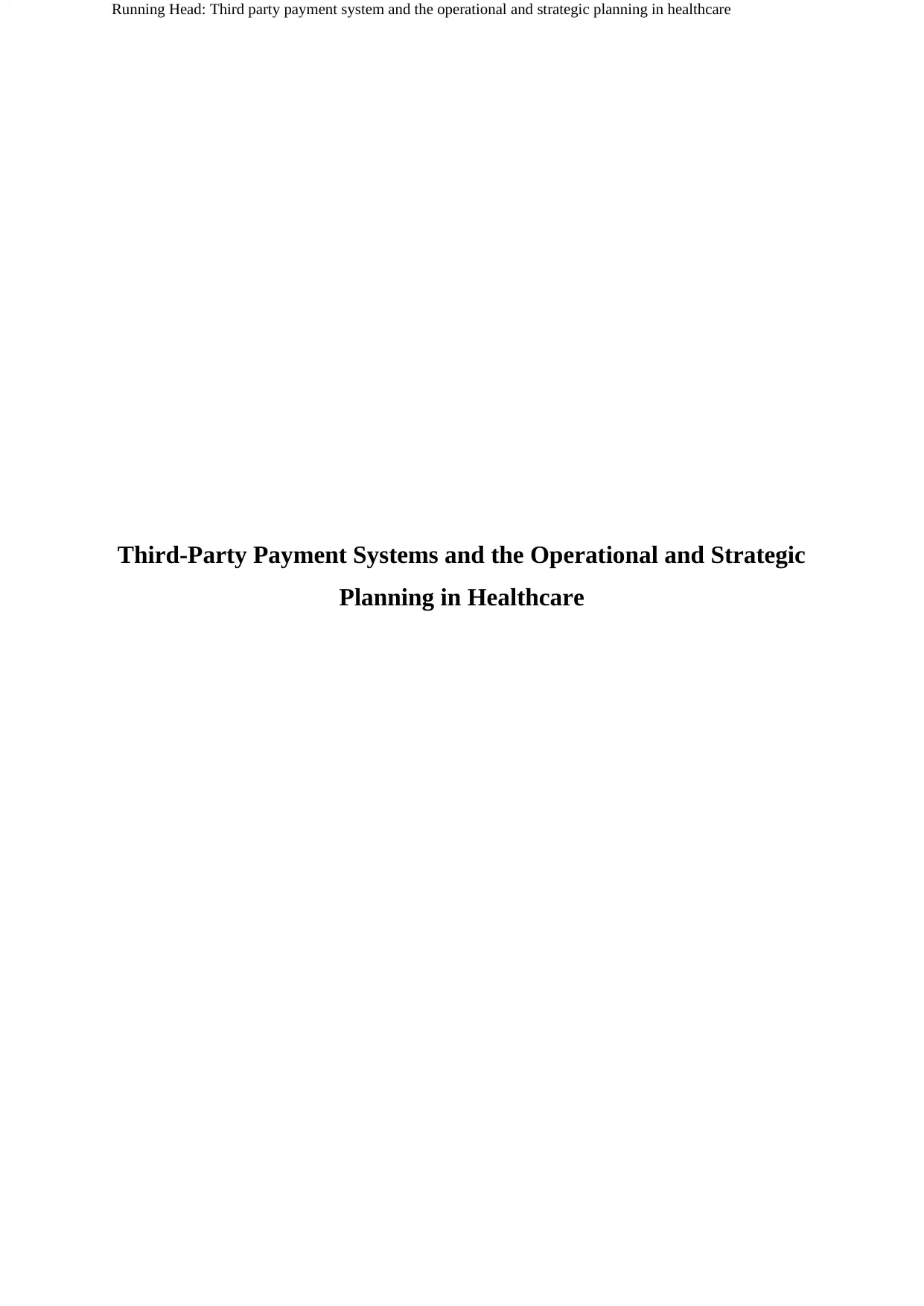
Running Head: Third party payment system and the operational and strategic planning in healthcare
Third-Party Payment Systems and the Operational and Strategic
Planning in Healthcare
Third-Party Payment Systems and the Operational and Strategic
Planning in Healthcare
Paraphrase This Document
Need a fresh take? Get an instant paraphrase of this document with our AI Paraphraser
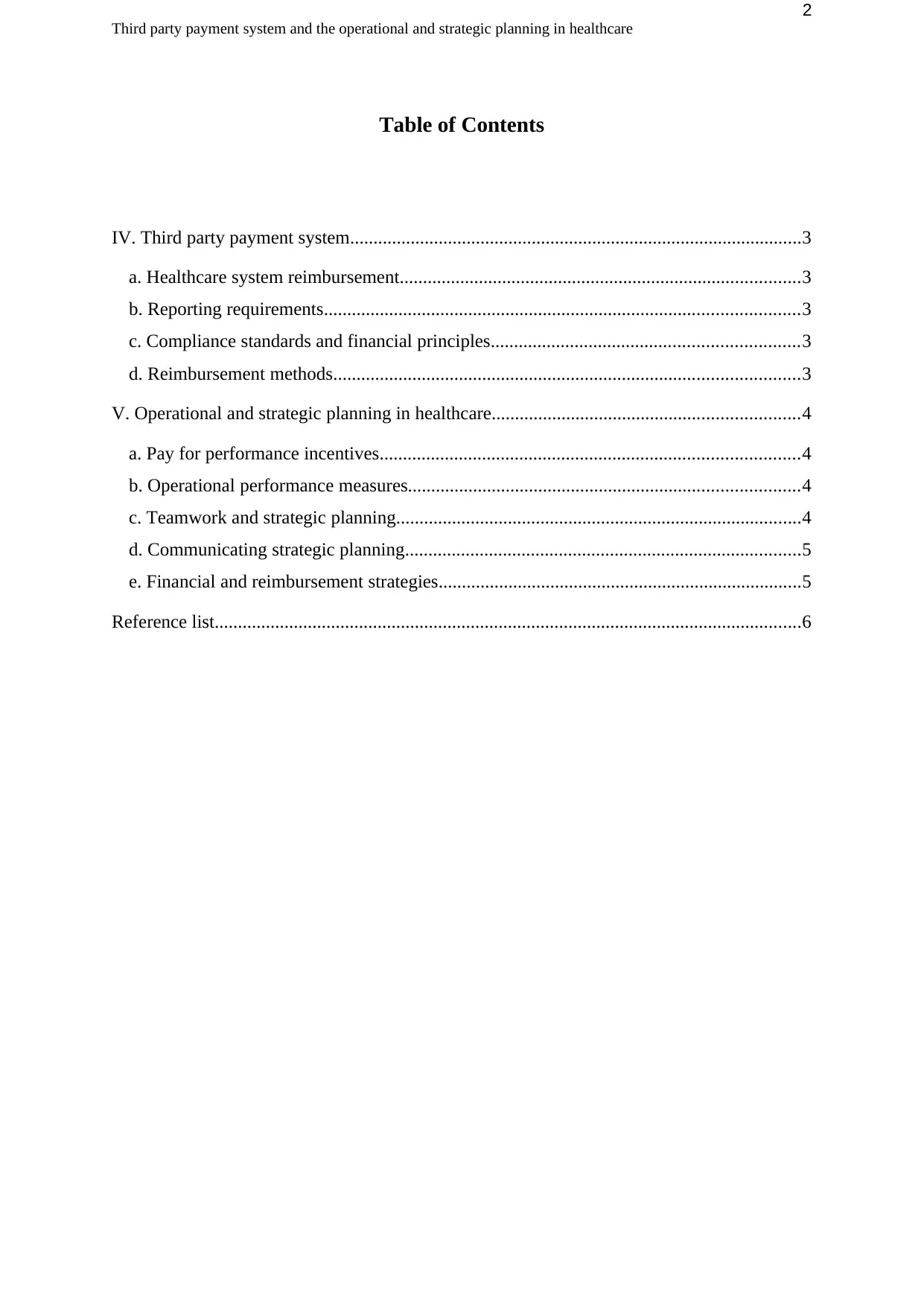
2
Third party payment system and the operational and strategic planning in healthcare
Table of Contents
IV. Third party payment system.................................................................................................3
a. Healthcare system reimbursement......................................................................................3
b. Reporting requirements......................................................................................................3
c. Compliance standards and financial principles..................................................................3
d. Reimbursement methods....................................................................................................3
V. Operational and strategic planning in healthcare..................................................................4
a. Pay for performance incentives..........................................................................................4
b. Operational performance measures....................................................................................4
c. Teamwork and strategic planning.......................................................................................4
d. Communicating strategic planning.....................................................................................5
e. Financial and reimbursement strategies..............................................................................5
Reference list..............................................................................................................................6
Third party payment system and the operational and strategic planning in healthcare
Table of Contents
IV. Third party payment system.................................................................................................3
a. Healthcare system reimbursement......................................................................................3
b. Reporting requirements......................................................................................................3
c. Compliance standards and financial principles..................................................................3
d. Reimbursement methods....................................................................................................3
V. Operational and strategic planning in healthcare..................................................................4
a. Pay for performance incentives..........................................................................................4
b. Operational performance measures....................................................................................4
c. Teamwork and strategic planning.......................................................................................4
d. Communicating strategic planning.....................................................................................5
e. Financial and reimbursement strategies..............................................................................5
Reference list..............................................................................................................................6
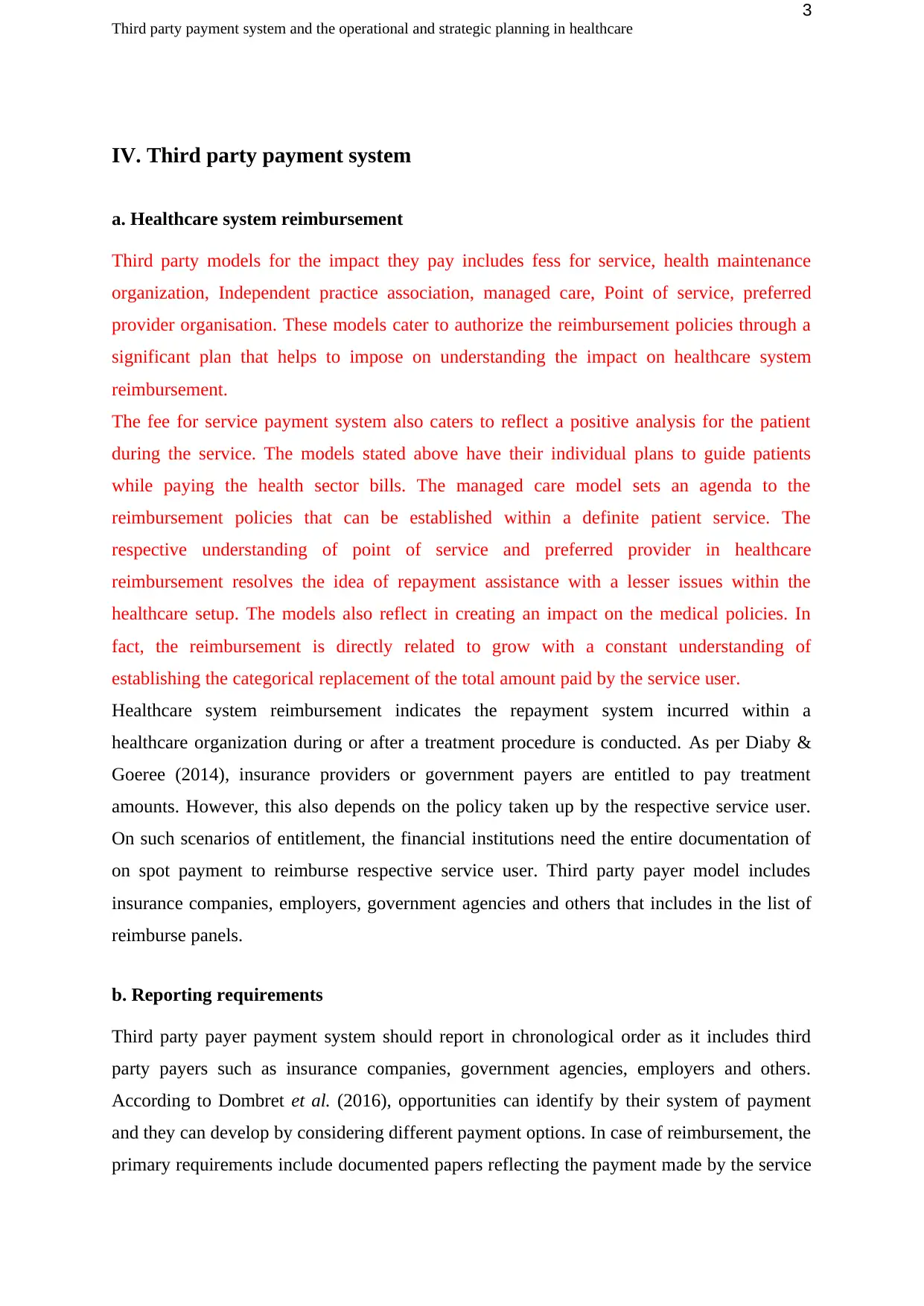
3
Third party payment system and the operational and strategic planning in healthcare
IV. Third party payment system
a. Healthcare system reimbursement
Third party models for the impact they pay includes fess for service, health maintenance
organization, Independent practice association, managed care, Point of service, preferred
provider organisation. These models cater to authorize the reimbursement policies through a
significant plan that helps to impose on understanding the impact on healthcare system
reimbursement.
The fee for service payment system also caters to reflect a positive analysis for the patient
during the service. The models stated above have their individual plans to guide patients
while paying the health sector bills. The managed care model sets an agenda to the
reimbursement policies that can be established within a definite patient service. The
respective understanding of point of service and preferred provider in healthcare
reimbursement resolves the idea of repayment assistance with a lesser issues within the
healthcare setup. The models also reflect in creating an impact on the medical policies. In
fact, the reimbursement is directly related to grow with a constant understanding of
establishing the categorical replacement of the total amount paid by the service user.
Healthcare system reimbursement indicates the repayment system incurred within a
healthcare organization during or after a treatment procedure is conducted. As per Diaby &
Goeree (2014), insurance providers or government payers are entitled to pay treatment
amounts. However, this also depends on the policy taken up by the respective service user.
On such scenarios of entitlement, the financial institutions need the entire documentation of
on spot payment to reimburse respective service user. Third party payer model includes
insurance companies, employers, government agencies and others that includes in the list of
reimburse panels.
b. Reporting requirements
Third party payer payment system should report in chronological order as it includes third
party payers such as insurance companies, government agencies, employers and others.
According to Dombret et al. (2016), opportunities can identify by their system of payment
and they can develop by considering different payment options. In case of reimbursement, the
primary requirements include documented papers reflecting the payment made by the service
Third party payment system and the operational and strategic planning in healthcare
IV. Third party payment system
a. Healthcare system reimbursement
Third party models for the impact they pay includes fess for service, health maintenance
organization, Independent practice association, managed care, Point of service, preferred
provider organisation. These models cater to authorize the reimbursement policies through a
significant plan that helps to impose on understanding the impact on healthcare system
reimbursement.
The fee for service payment system also caters to reflect a positive analysis for the patient
during the service. The models stated above have their individual plans to guide patients
while paying the health sector bills. The managed care model sets an agenda to the
reimbursement policies that can be established within a definite patient service. The
respective understanding of point of service and preferred provider in healthcare
reimbursement resolves the idea of repayment assistance with a lesser issues within the
healthcare setup. The models also reflect in creating an impact on the medical policies. In
fact, the reimbursement is directly related to grow with a constant understanding of
establishing the categorical replacement of the total amount paid by the service user.
Healthcare system reimbursement indicates the repayment system incurred within a
healthcare organization during or after a treatment procedure is conducted. As per Diaby &
Goeree (2014), insurance providers or government payers are entitled to pay treatment
amounts. However, this also depends on the policy taken up by the respective service user.
On such scenarios of entitlement, the financial institutions need the entire documentation of
on spot payment to reimburse respective service user. Third party payer model includes
insurance companies, employers, government agencies and others that includes in the list of
reimburse panels.
b. Reporting requirements
Third party payer payment system should report in chronological order as it includes third
party payers such as insurance companies, government agencies, employers and others.
According to Dombret et al. (2016), opportunities can identify by their system of payment
and they can develop by considering different payment options. In case of reimbursement, the
primary requirements include documented papers reflecting the payment made by the service
⊘ This is a preview!⊘
Do you want full access?
Subscribe today to unlock all pages.

Trusted by 1+ million students worldwide
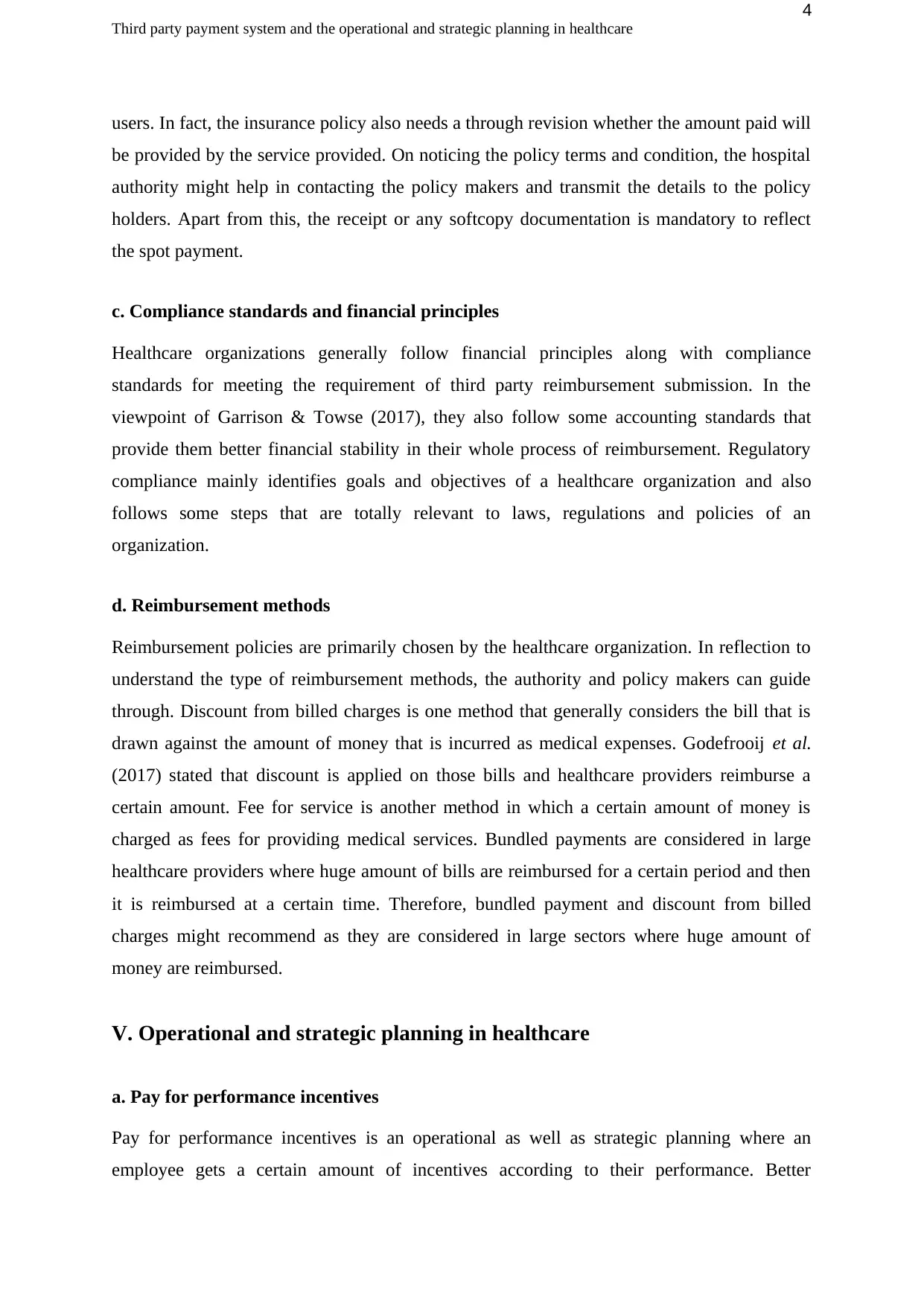
4
Third party payment system and the operational and strategic planning in healthcare
users. In fact, the insurance policy also needs a through revision whether the amount paid will
be provided by the service provided. On noticing the policy terms and condition, the hospital
authority might help in contacting the policy makers and transmit the details to the policy
holders. Apart from this, the receipt or any softcopy documentation is mandatory to reflect
the spot payment.
c. Compliance standards and financial principles
Healthcare organizations generally follow financial principles along with compliance
standards for meeting the requirement of third party reimbursement submission. In the
viewpoint of Garrison & Towse (2017), they also follow some accounting standards that
provide them better financial stability in their whole process of reimbursement. Regulatory
compliance mainly identifies goals and objectives of a healthcare organization and also
follows some steps that are totally relevant to laws, regulations and policies of an
organization.
d. Reimbursement methods
Reimbursement policies are primarily chosen by the healthcare organization. In reflection to
understand the type of reimbursement methods, the authority and policy makers can guide
through. Discount from billed charges is one method that generally considers the bill that is
drawn against the amount of money that is incurred as medical expenses. Godefrooij et al.
(2017) stated that discount is applied on those bills and healthcare providers reimburse a
certain amount. Fee for service is another method in which a certain amount of money is
charged as fees for providing medical services. Bundled payments are considered in large
healthcare providers where huge amount of bills are reimbursed for a certain period and then
it is reimbursed at a certain time. Therefore, bundled payment and discount from billed
charges might recommend as they are considered in large sectors where huge amount of
money are reimbursed.
V. Operational and strategic planning in healthcare
a. Pay for performance incentives
Pay for performance incentives is an operational as well as strategic planning where an
employee gets a certain amount of incentives according to their performance. Better
Third party payment system and the operational and strategic planning in healthcare
users. In fact, the insurance policy also needs a through revision whether the amount paid will
be provided by the service provided. On noticing the policy terms and condition, the hospital
authority might help in contacting the policy makers and transmit the details to the policy
holders. Apart from this, the receipt or any softcopy documentation is mandatory to reflect
the spot payment.
c. Compliance standards and financial principles
Healthcare organizations generally follow financial principles along with compliance
standards for meeting the requirement of third party reimbursement submission. In the
viewpoint of Garrison & Towse (2017), they also follow some accounting standards that
provide them better financial stability in their whole process of reimbursement. Regulatory
compliance mainly identifies goals and objectives of a healthcare organization and also
follows some steps that are totally relevant to laws, regulations and policies of an
organization.
d. Reimbursement methods
Reimbursement policies are primarily chosen by the healthcare organization. In reflection to
understand the type of reimbursement methods, the authority and policy makers can guide
through. Discount from billed charges is one method that generally considers the bill that is
drawn against the amount of money that is incurred as medical expenses. Godefrooij et al.
(2017) stated that discount is applied on those bills and healthcare providers reimburse a
certain amount. Fee for service is another method in which a certain amount of money is
charged as fees for providing medical services. Bundled payments are considered in large
healthcare providers where huge amount of bills are reimbursed for a certain period and then
it is reimbursed at a certain time. Therefore, bundled payment and discount from billed
charges might recommend as they are considered in large sectors where huge amount of
money are reimbursed.
V. Operational and strategic planning in healthcare
a. Pay for performance incentives
Pay for performance incentives is an operational as well as strategic planning where an
employee gets a certain amount of incentives according to their performance. Better
Paraphrase This Document
Need a fresh take? Get an instant paraphrase of this document with our AI Paraphraser
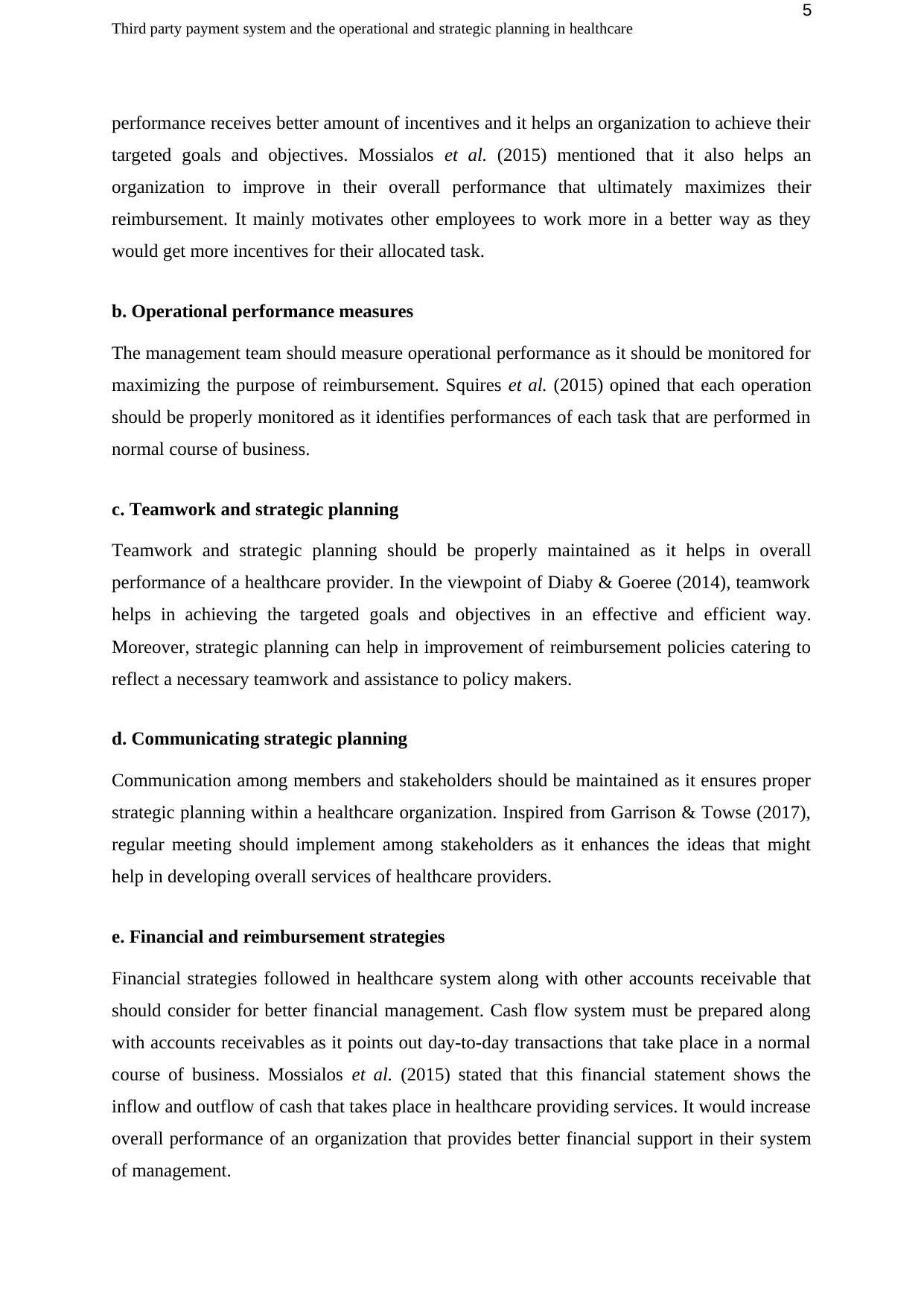
5
Third party payment system and the operational and strategic planning in healthcare
performance receives better amount of incentives and it helps an organization to achieve their
targeted goals and objectives. Mossialos et al. (2015) mentioned that it also helps an
organization to improve in their overall performance that ultimately maximizes their
reimbursement. It mainly motivates other employees to work more in a better way as they
would get more incentives for their allocated task.
b. Operational performance measures
The management team should measure operational performance as it should be monitored for
maximizing the purpose of reimbursement. Squires et al. (2015) opined that each operation
should be properly monitored as it identifies performances of each task that are performed in
normal course of business.
c. Teamwork and strategic planning
Teamwork and strategic planning should be properly maintained as it helps in overall
performance of a healthcare provider. In the viewpoint of Diaby & Goeree (2014), teamwork
helps in achieving the targeted goals and objectives in an effective and efficient way.
Moreover, strategic planning can help in improvement of reimbursement policies catering to
reflect a necessary teamwork and assistance to policy makers.
d. Communicating strategic planning
Communication among members and stakeholders should be maintained as it ensures proper
strategic planning within a healthcare organization. Inspired from Garrison & Towse (2017),
regular meeting should implement among stakeholders as it enhances the ideas that might
help in developing overall services of healthcare providers.
e. Financial and reimbursement strategies
Financial strategies followed in healthcare system along with other accounts receivable that
should consider for better financial management. Cash flow system must be prepared along
with accounts receivables as it points out day-to-day transactions that take place in a normal
course of business. Mossialos et al. (2015) stated that this financial statement shows the
inflow and outflow of cash that takes place in healthcare providing services. It would increase
overall performance of an organization that provides better financial support in their system
of management.
Third party payment system and the operational and strategic planning in healthcare
performance receives better amount of incentives and it helps an organization to achieve their
targeted goals and objectives. Mossialos et al. (2015) mentioned that it also helps an
organization to improve in their overall performance that ultimately maximizes their
reimbursement. It mainly motivates other employees to work more in a better way as they
would get more incentives for their allocated task.
b. Operational performance measures
The management team should measure operational performance as it should be monitored for
maximizing the purpose of reimbursement. Squires et al. (2015) opined that each operation
should be properly monitored as it identifies performances of each task that are performed in
normal course of business.
c. Teamwork and strategic planning
Teamwork and strategic planning should be properly maintained as it helps in overall
performance of a healthcare provider. In the viewpoint of Diaby & Goeree (2014), teamwork
helps in achieving the targeted goals and objectives in an effective and efficient way.
Moreover, strategic planning can help in improvement of reimbursement policies catering to
reflect a necessary teamwork and assistance to policy makers.
d. Communicating strategic planning
Communication among members and stakeholders should be maintained as it ensures proper
strategic planning within a healthcare organization. Inspired from Garrison & Towse (2017),
regular meeting should implement among stakeholders as it enhances the ideas that might
help in developing overall services of healthcare providers.
e. Financial and reimbursement strategies
Financial strategies followed in healthcare system along with other accounts receivable that
should consider for better financial management. Cash flow system must be prepared along
with accounts receivables as it points out day-to-day transactions that take place in a normal
course of business. Mossialos et al. (2015) stated that this financial statement shows the
inflow and outflow of cash that takes place in healthcare providing services. It would increase
overall performance of an organization that provides better financial support in their system
of management.

6
Third party payment system and the operational and strategic planning in healthcare
Third party payment system and the operational and strategic planning in healthcare
⊘ This is a preview!⊘
Do you want full access?
Subscribe today to unlock all pages.

Trusted by 1+ million students worldwide
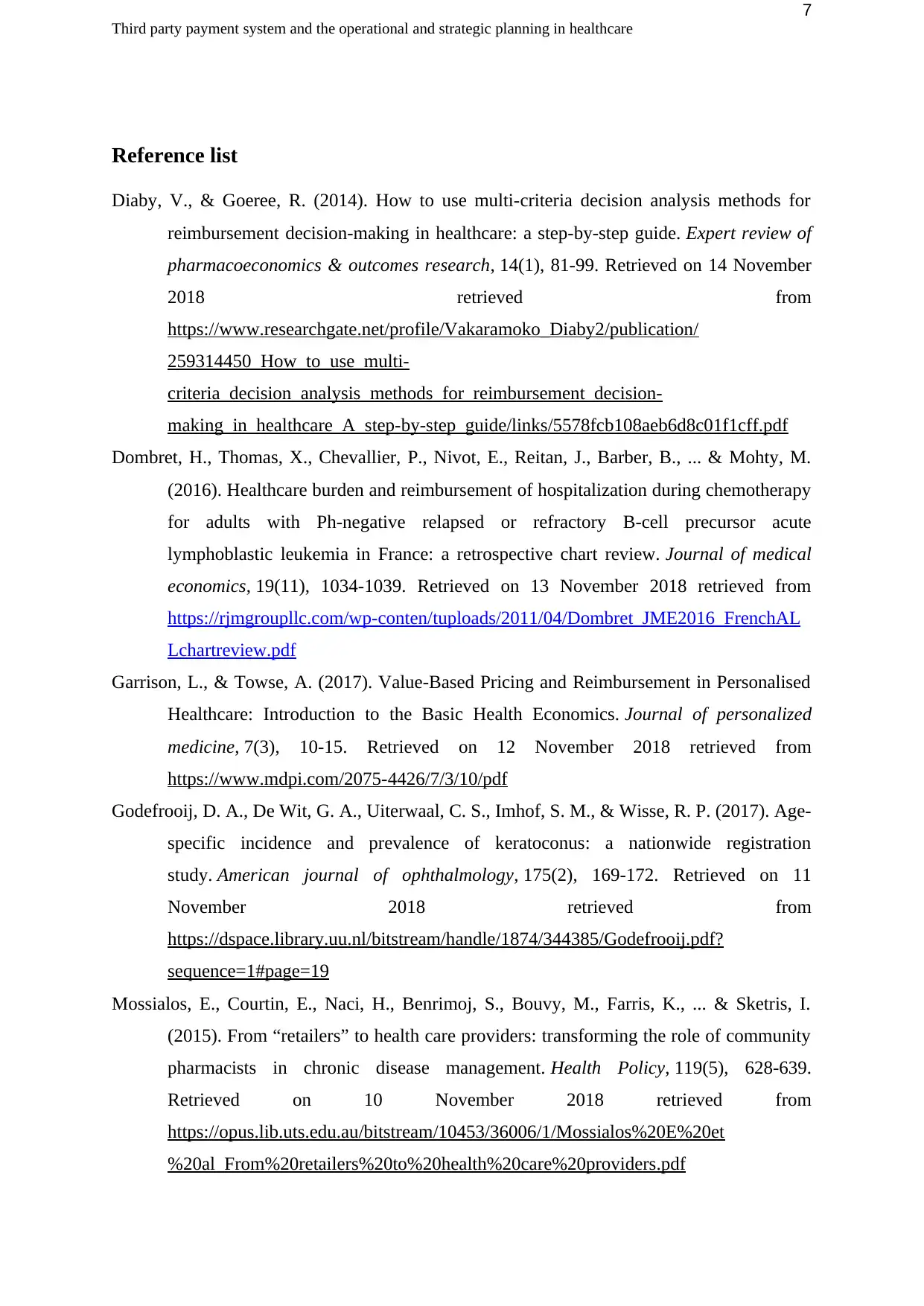
7
Third party payment system and the operational and strategic planning in healthcare
Reference list
Diaby, V., & Goeree, R. (2014). How to use multi-criteria decision analysis methods for
reimbursement decision-making in healthcare: a step-by-step guide. Expert review of
pharmacoeconomics & outcomes research, 14(1), 81-99. Retrieved on 14 November
2018 retrieved from
https://www.researchgate.net/profile/Vakaramoko_Diaby2/publication/
259314450_How_to_use_multi-
criteria_decision_analysis_methods_for_reimbursement_decision-
making_in_healthcare_A_step-by-step_guide/links/5578fcb108aeb6d8c01f1cff.pdf
Dombret, H., Thomas, X., Chevallier, P., Nivot, E., Reitan, J., Barber, B., ... & Mohty, M.
(2016). Healthcare burden and reimbursement of hospitalization during chemotherapy
for adults with Ph-negative relapsed or refractory B-cell precursor acute
lymphoblastic leukemia in France: a retrospective chart review. Journal of medical
economics, 19(11), 1034-1039. Retrieved on 13 November 2018 retrieved from
https://rjmgroupllc.com/wp-conten/tuploads/2011/04/Dombret_JME2016_FrenchAL
Lchartreview.pdf
Garrison, L., & Towse, A. (2017). Value-Based Pricing and Reimbursement in Personalised
Healthcare: Introduction to the Basic Health Economics. Journal of personalized
medicine, 7(3), 10-15. Retrieved on 12 November 2018 retrieved from
https://www.mdpi.com/2075-4426/7/3/10/pdf
Godefrooij, D. A., De Wit, G. A., Uiterwaal, C. S., Imhof, S. M., & Wisse, R. P. (2017). Age-
specific incidence and prevalence of keratoconus: a nationwide registration
study. American journal of ophthalmology, 175(2), 169-172. Retrieved on 11
November 2018 retrieved from
https://dspace.library.uu.nl/bitstream/handle/1874/344385/Godefrooij.pdf?
sequence=1#page=19
Mossialos, E., Courtin, E., Naci, H., Benrimoj, S., Bouvy, M., Farris, K., ... & Sketris, I.
(2015). From “retailers” to health care providers: transforming the role of community
pharmacists in chronic disease management. Health Policy, 119(5), 628-639.
Retrieved on 10 November 2018 retrieved from
https://opus.lib.uts.edu.au/bitstream/10453/36006/1/Mossialos%20E%20et
%20al_From%20retailers%20to%20health%20care%20providers.pdf
Third party payment system and the operational and strategic planning in healthcare
Reference list
Diaby, V., & Goeree, R. (2014). How to use multi-criteria decision analysis methods for
reimbursement decision-making in healthcare: a step-by-step guide. Expert review of
pharmacoeconomics & outcomes research, 14(1), 81-99. Retrieved on 14 November
2018 retrieved from
https://www.researchgate.net/profile/Vakaramoko_Diaby2/publication/
259314450_How_to_use_multi-
criteria_decision_analysis_methods_for_reimbursement_decision-
making_in_healthcare_A_step-by-step_guide/links/5578fcb108aeb6d8c01f1cff.pdf
Dombret, H., Thomas, X., Chevallier, P., Nivot, E., Reitan, J., Barber, B., ... & Mohty, M.
(2016). Healthcare burden and reimbursement of hospitalization during chemotherapy
for adults with Ph-negative relapsed or refractory B-cell precursor acute
lymphoblastic leukemia in France: a retrospective chart review. Journal of medical
economics, 19(11), 1034-1039. Retrieved on 13 November 2018 retrieved from
https://rjmgroupllc.com/wp-conten/tuploads/2011/04/Dombret_JME2016_FrenchAL
Lchartreview.pdf
Garrison, L., & Towse, A. (2017). Value-Based Pricing and Reimbursement in Personalised
Healthcare: Introduction to the Basic Health Economics. Journal of personalized
medicine, 7(3), 10-15. Retrieved on 12 November 2018 retrieved from
https://www.mdpi.com/2075-4426/7/3/10/pdf
Godefrooij, D. A., De Wit, G. A., Uiterwaal, C. S., Imhof, S. M., & Wisse, R. P. (2017). Age-
specific incidence and prevalence of keratoconus: a nationwide registration
study. American journal of ophthalmology, 175(2), 169-172. Retrieved on 11
November 2018 retrieved from
https://dspace.library.uu.nl/bitstream/handle/1874/344385/Godefrooij.pdf?
sequence=1#page=19
Mossialos, E., Courtin, E., Naci, H., Benrimoj, S., Bouvy, M., Farris, K., ... & Sketris, I.
(2015). From “retailers” to health care providers: transforming the role of community
pharmacists in chronic disease management. Health Policy, 119(5), 628-639.
Retrieved on 10 November 2018 retrieved from
https://opus.lib.uts.edu.au/bitstream/10453/36006/1/Mossialos%20E%20et
%20al_From%20retailers%20to%20health%20care%20providers.pdf
Paraphrase This Document
Need a fresh take? Get an instant paraphrase of this document with our AI Paraphraser
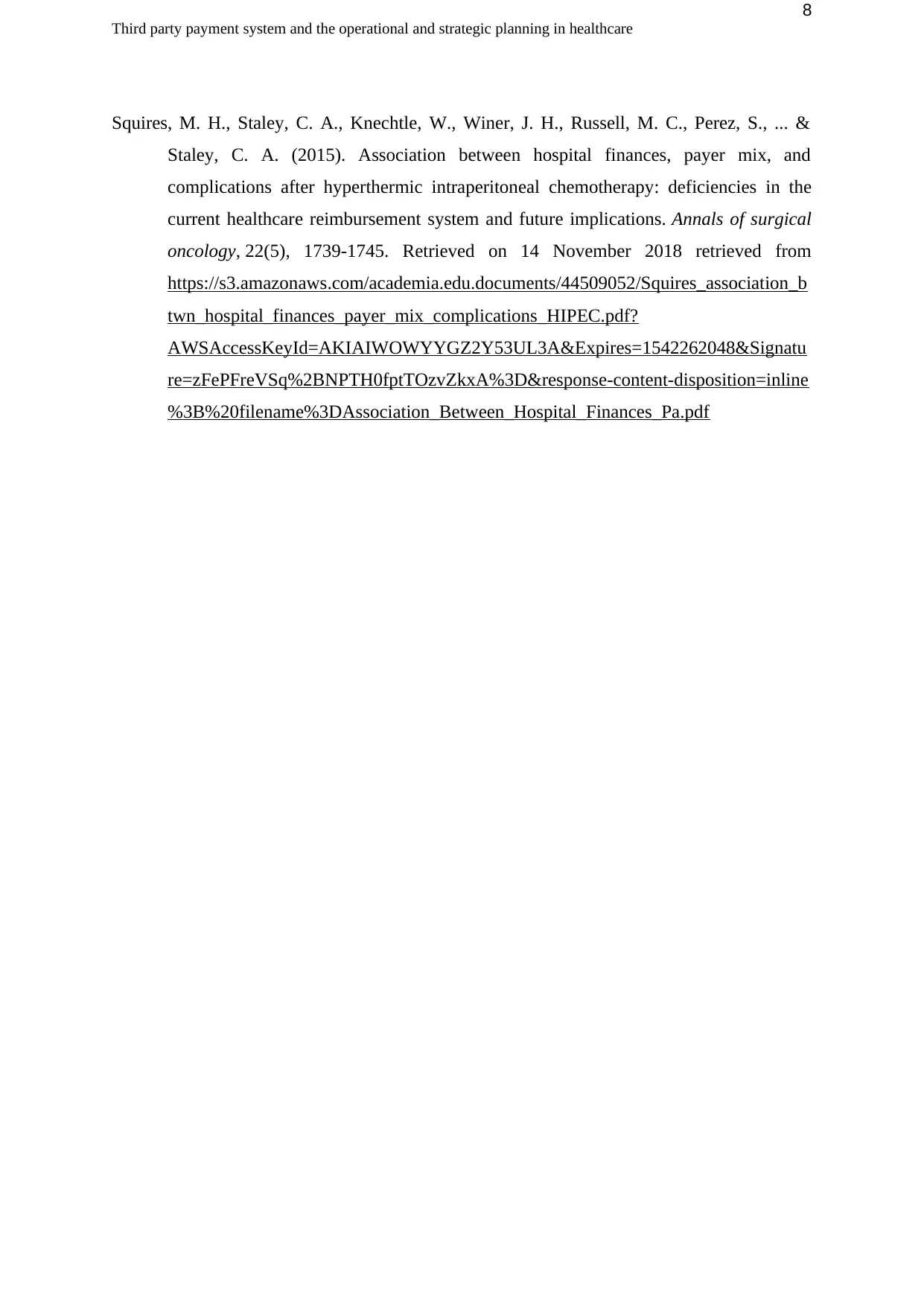
8
Third party payment system and the operational and strategic planning in healthcare
Squires, M. H., Staley, C. A., Knechtle, W., Winer, J. H., Russell, M. C., Perez, S., ... &
Staley, C. A. (2015). Association between hospital finances, payer mix, and
complications after hyperthermic intraperitoneal chemotherapy: deficiencies in the
current healthcare reimbursement system and future implications. Annals of surgical
oncology, 22(5), 1739-1745. Retrieved on 14 November 2018 retrieved from
https://s3.amazonaws.com/academia.edu.documents/44509052/Squires_association_b
twn_hospital_finances_payer_mix_complications_HIPEC.pdf?
AWSAccessKeyId=AKIAIWOWYYGZ2Y53UL3A&Expires=1542262048&Signatu
re=zFePFreVSq%2BNPTH0fptTOzvZkxA%3D&response-content-disposition=inline
%3B%20filename%3DAssociation_Between_Hospital_Finances_Pa.pdf
Third party payment system and the operational and strategic planning in healthcare
Squires, M. H., Staley, C. A., Knechtle, W., Winer, J. H., Russell, M. C., Perez, S., ... &
Staley, C. A. (2015). Association between hospital finances, payer mix, and
complications after hyperthermic intraperitoneal chemotherapy: deficiencies in the
current healthcare reimbursement system and future implications. Annals of surgical
oncology, 22(5), 1739-1745. Retrieved on 14 November 2018 retrieved from
https://s3.amazonaws.com/academia.edu.documents/44509052/Squires_association_b
twn_hospital_finances_payer_mix_complications_HIPEC.pdf?
AWSAccessKeyId=AKIAIWOWYYGZ2Y53UL3A&Expires=1542262048&Signatu
re=zFePFreVSq%2BNPTH0fptTOzvZkxA%3D&response-content-disposition=inline
%3B%20filename%3DAssociation_Between_Hospital_Finances_Pa.pdf
1 out of 8
Related Documents
Your All-in-One AI-Powered Toolkit for Academic Success.
+13062052269
info@desklib.com
Available 24*7 on WhatsApp / Email
![[object Object]](/_next/static/media/star-bottom.7253800d.svg)
Unlock your academic potential
Copyright © 2020–2025 A2Z Services. All Rights Reserved. Developed and managed by ZUCOL.




